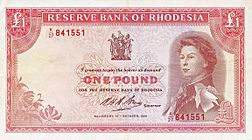Rhodesian pound facts for kids
Quick facts for kids Rhodesian pound |
|||
|---|---|---|---|
|
|||
| User(s) | |||
| Pegged with | £1 sterling at par, later £1 Rhodesian = US$2.80 | ||
| Subunit | |||
| 1⁄20 | shilling | ||
| 1⁄240 | penny | ||
| Symbol | £ | ||
| shilling | s or /– | ||
| penny | d | ||
| Plural | pounds | ||
| penny | pence | ||
| Coins | 3d, 6d, 1/-, 2/–, 2/6 | ||
| Banknotes | 10/–, £1, £5 | ||
| Printer | Bradbury Wilkinson (before 1965) in Rhodesia between 1966 and October 1968 |
||
The Rhodesian pound was the money used in Southern Rhodesia from 1964 to 1965. It was also the money for Rhodesia from 1965 until 1970. One pound was divided into 20 shillings, and each shilling had 12 pence.
History of the Rhodesian Pound
The Rhodesian pound started being used after the Federation of Rhodesia and Nyasaland broke up. This was when Southern Rhodesia changed its name to just Rhodesia. The new Rhodesian pound took the place of the old Rhodesia and Nyasaland pound. They were worth the same, so the old coins and banknotes could still be used.
At first, the Rhodesian pound was linked to the British pound. This meant they had the same value. In 1967, the British pound's value changed compared to the US dollar. So, Rhodesia decided to link its pound directly to the US dollar instead. One Rhodesian pound became worth US$2.80.
In 1970, the Rhodesian pound was replaced by the Rhodesian dollar. One Rhodesian pound was then worth two Rhodesian dollars. This meant one Rhodesian dollar was worth US$1.40.
Coins of Rhodesia
In 1964, new coins were made for 6 pence, 1 shilling, 2 shillings, and 2 shillings and 6 pence. These coins also showed their value in cents (5c, 10c, 20c, and 25c). This was interesting because Rhodesia didn't officially switch to a decimal money system until 1970. This might have been to make them work with the South African rand, which was linked to the Rhodesian pound until 1967.
In 1968, 3 pence coins were also made, but these did not show a value in cents. All the coins had the name of Queen Elizabeth II written in English. Before this, on older coins, her name was often in Latin.
Banknotes of Rhodesia
Starting in 1964, banknotes (paper money) were printed for 10 shillings, £1, and £5. All these notes had a picture of Queen Elizabeth II on the front. The pictures on the back of these notes were later used again for the new dollar notes that came out in 1970. The Rhodesian dollar notes looked similar, but they had the new dollar amounts. Also, the bank's logo replaced the country's coat of arms, and the coat of arms replaced the Queen's picture.
Before Rhodesia declared its independence (called UDI), it was part of the "sterling zone." This meant it used the British pound system. The banknotes were printed in the UK by a company called Bradbury Wilkinson. After UDI, the British government stopped Rhodesia from being part of the sterling zone. This also meant they stopped sending new banknotes. Soon, Rhodesia had a problem because there weren't enough new notes, and the old ones were getting worn out.
In 1966, the Reserve Bank of Rhodesia tried to order a whole new set of banknotes from a German company. But a court stopped these notes from being sent to Rhodesia. So, the whole order was destroyed. Because of this, new banknotes had to be printed inside Rhodesia between 1966 and October 1968.
Images for kids














